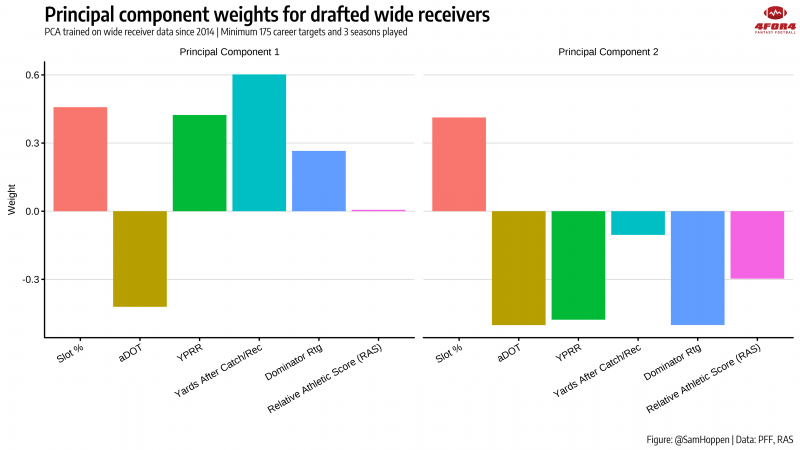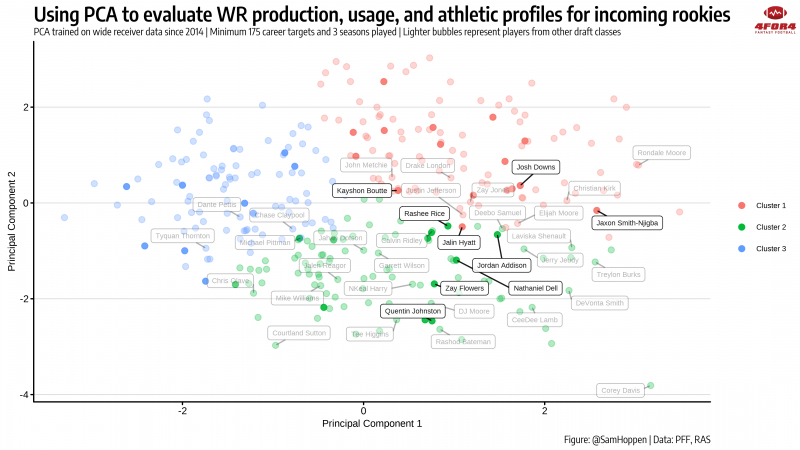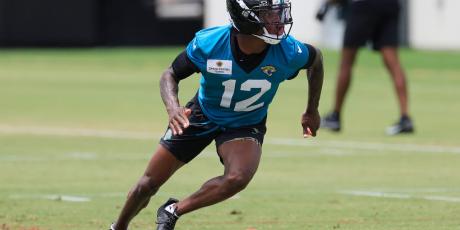NFL Draft Prospect Comparisons: Wide Receiver

With the NFL combine now behind us, we have another piece of the puzzle filled in for prospect evaluations. While not every prospect participated in drills (or even attended the combine), those who did, provided us with some valuable information. There were some players whose stock rose over the weekend while some players may have wished they didn't go to Indianapolis.
But, with this new data comes a new analysis. Last year, I wrote about college prospect profiles using only combine results, but this year I wanted to expand on that and get a more complete picture of who these players are. To do this, I use a technique called clustering, which allows me to bucket these players into a number of statistical profiles and compare them to one another. In the clustering, I included a combination of production, efficiency, athleticism, and usage metrics in hopes of capturing who these players really are.
More NFL Draft and Rookie Content: Scott Smith's 2023 Mock Draft Version 1.0 | 11 Players Who Turned Heads at the NFL Combine | 10 Fantasy Relevant Rookies: A First Look | Connor Allen's 2023 NFL Mock Draft 1.0 | NFL Draft Prospect Comparisons: Running Back
This article will cover both the methodology that I used along with commentary on some of the standout players from the 2023 class. Draft season is in full swing!
Note: all college stats used in the clustering are for a player's full career in school.
Methodology
Before I get into the analysis, I want to explain the methodology and techniques that I used along with delineating what this analysis is and, more importantly, what it is not. Let's start off with the latter.
This analysis is a descriptive way to compare a player's college stats and athleticism to historical results. This is not a predictive indicator of future NFL and fantasy success or that a player with a similar historical profile will have the same career.
In terms of the methodology, I used a Principal Component Analysis (PCA) using data since 2014. If you're unfamiliar with PCA, it is a way to "squish" several variables (in this case, each of our combine metrics), into just a couple of variables - our principal components - thus simplifying our dataset and reducing noise. Put another way, PCA helps us find fewer features that will represent our data in a more compressed way.
This also allows me to visualize the results on two axes using the first two principal components, which I wouldn't be able to do easily with the several combine metrics that we have. This is also where we'll be able to see player comparisons - players that appear further away from the center of the chart are more unique in their results and fall into a more distinct category.
For wide receivers, below are the weights for the combine metrics for each of the two principal components. To calculate a player's principal component, you can read these as linear equations. So for principal component one, a player's score is calculated as (0.46*Slot %) + (-0.42*aDOT) + (0.42*YPRR) + (0.60*Yards After Catch/Rec) + (0.27*Dominator Rtg) + (0.01*Relative Athletic Score).

2023 Wide Receiver Class Standouts
This wide receiver draft class is a bit unique in that there really isn't a blue-chip prospect that's seen as an X receiver. Many of the receivers have been pegged as role players. To the casual fan (which you aren't because you're reading this article) this may make it seem like the draft class is a bit weaker. But, studies have shown the value of secondary (and tertiary) receiving options on teams, making wide receiver a position of need for many teams entering the draft. The chart below highlights some of the top names from this upcoming draft, followed by my analysis of each.
The chart below highlights some players for this year's rookie class (that I will further discuss) along with wide receivers drafted in the top 50 that were included in my sample.

Quentin Johnston (TCU)
Quentin Johnston has been the betting favorite to be the first wide receiver taken off of the board for a while but has recently been surpassed by Jaxon Smith-Njigba. Johnston is the best true X receiver in this class while also having name recognition thanks to playing in the national championship. Johnston also produced extremely well in his final season with TCU, boasting an excellent 3.05 yards per route run, which was in the 88th percentile in 2022 (per PFF).
Throughout college, Johnston was split out wide on nearly 90% of his snaps, showing just how much of an outside receiver he is. Additionally, he demonstrated his downfield receiving ability with a 15.6-yard average depth of target. I would be shocked if Johnston didn't go in the first round given how many teams have a need at receiver, but whether he'll be the first one taken will depend on which team jumps the gun first.
Comparable cluster profiles: Rashod Bateman, Tee Higgins
Jordan Addison (USC, transferred there after two seasons at Pitt)
Unfortunately, Jordan Addison is one of the people who may have been better off staying home instead of going to Indianapolis. Per Hayden Winks, Addison's 4.49-second 40-yard dash was 39th percentile, but it was an abysmal third percentile when adjusted for weight. We also know from some research by Kevin Cole that 40-yard-dash time is highly overvalued in the draft. So, Addison may fall in the draft this April, but I'm here to squash some of the concerns about Addison.
First, he recorded a really strong 2.78 yards per route run at USC. Addison also demonstrated that he can play from multiple areas of the field. In his first two seasons with Pitt, Addison spent 75% of his snaps in the slot, but when he went to USC he only played 18.7% of his snaps from the slot - an outrageous difference! While he was excellent at creating separation, he posted just 6.3 yards after catch per reception throughout college. At just 6'0" and 175 pounds, Addison is not the jump-ball receiver as he posted just a 22.2% contested catch rate in his final season, but his shiftiness and balance will make a team fall in love with him.
Comparable cluster profiles: Deebo Samuel, James Proche
Jaxon Smith-Njigba (Ohio State)
Jaxon Smith-Njigba is a very interesting case and I've waffled back and forth on my opinion of him a lot over the past couple of weeks. A large part of this is that he missed the majority of his final season battling a hamstring injury. Because of this, he really only has one outstanding season under his belt and now, as I mentioned, he's the betting favorite to be the number one wide receiver drafted. That one season though - whew, was it good.
As a sophomore, Smith-Njigba averaged an elite 4.01 yards per route run and 8.3 yards after catch per reception, all while competing with former first-round talents in Garret Wilson and Chris Olave. Not to mention, he did all of this running the majority of his routes out of the slot. As I reach the end of this section, I'm now more sold on Smith-Njigba being an elite primary slot option for a team that can pair him with a dominant receiver out wide.
Comparable cluster profiles: Christian Kirk, Olamide Zaccheaus
Zay Flowers (Boston College)
In one of the bigger offseason changes we've seen, Zay Flowers put on over 10 pounds of muscle. That made his 4.42-second 40-yard dash all the more impressive. He may need this because his efficiency numbers aren't all that impressive. A career 2.16 yards per route run and 6.75 yards after catch per reception aren't all that impressive.
But, despite his smaller stature, Flowers was a ball hawk in his final season and posted a contested catch rate of 58.3% in 2022. Flowers also had a 33.3% dominator rating in his career, which was the eighth-highest in my 310-player sample used for this analysis. Flowers spent the majority of his time split out wide, but also demonstrated an ability to play from the slot.
Comparable cluster profiles: N'Keal Harry, Hakeem Butler
Nathaniel Dell (Houston)
Nathaniel Dell, also known as Tank Dell, is another outlier in terms of his size (despite what his nickname suggests). At 5'8" and 165 pounds, Dell is in just the fourth and second percentile for height and weight, respectively. Since 1999, only three wide receivers - Tutu Atwell, Marquise Brown, and DeSean Jackson - have weighed under 170 pounds and have been selected in the first three rounds of the draft.
Fortunately, Dell comes with some solid production as he had 1,300 receiving yards and a dozen touchdowns in the final two years of his career at Houston. He also averaged 2.81 yards per team pass attempt last year, the third-most among players in this year's class. Because of his small stature, Dell is also able to wiggle away from defenders rather easily, but that also may be part of the defenses he faced in the AAC. He'll need to leverage this separation in the NFL if he has hopes of avoiding contact from the bulkier defenders.
Comparable cluster profiles: Quez Watkins, Diontae Johnson
Josh Downs (North Carolina)
In my opinion, Josh Downs may be one of the more underrated players in this class. Downs is coming off of back-to-back 1,000-yard seasons and is a two-time 1st-team All-ACC selection. He is a true slot guy with a 93.9% slot rate in college, but he also excelled against man coverage. Downs has incredibly quick change-of-direction movement that helps him win at his smaller size.
Yes this is a Josh Downs tweet
— Brett Kollmann (@BrettKollmann) February 23, 2023
Downs has also been strong after the catch. Per NBC Sports, Among Power Five receivers who saw 200+ snaps from the slot, Downs ranked 11th in yards after the catch with 375. He also had an exceptional 7.4 yards after catch per reception in 2021. Maybe I'm looking in the wrong places, but I really don't see the downside case for Downs right now.
Comparable cluster profiles: Scottie Miller, Penny Hart
Kayshon Boutte (LSU)
"Confidence is key," is a mantra I imagine Kayshon Boutte utters to himself in the morning because he still thinks he's WR1 in this class. However, his 4.73 RAS (second-lowest in this class) would suggest otherwise. This has continued a downward trajectory for Boutte's career, too. As a 5-star recruit, Boutte led LSU in receiving yards as a freshman during the COVID season and followed it up with a 41% dominator rating as a sophomore, but that season was cut short by an ankle injury. He then finished his career with just 538 receiving yards and a 64.9 PFF grade.
Similar to Addison, Boutte has also seen a big shift in his positional usage. In his first year, Boutte lined up from the slot on just 7% of his snaps. By his final year, he was lined up in the slot on nearly 74% of his snaps. In a class with several other superior slot options, Boutte could slide down draft boards.
Comparable cluster profiles: Amon-Ra St. Brown, Devin Duvernay
Jalin Hyatt (Tennessee)
Jalin Hyatt seems to be one of the more polarizing players in this draft class. First of all, he's extremely athletic: his 9.46 Relative Athletic Score ranked seventh in the class and 18th overall thanks to posting a 4.40-second 40-yard time. This will make him valuable to a team as he can take the top off of defenses. Second, he was efficient against both man and zone defenses in his final season with Tennessee. Thanks to that efficiency, he posted his first (and only) 1,300-yard season in 2022 and won the Biletnikoff award as the nation's top wide receiver.
The concern, though, comes with his freshman and sophomore seasons, during which he was a non-factor in Tennessee's offense. His total stat line in those two seasons was 41 receptions for 502 yards and four receiving touchdowns. Some have also noted that he may have just been a product of a great scheme and Hendon Hooker having a Heisman-worthy season. If his final-season numbers do hold up, he could be one of the steals of the draft.
Comparable cluster profiles: Elijah Moore, Khalil Shakir
Rashee Rice (SMU)
Rashee Rice's 9.65 RAS is the 12th-highest score for the 310 receivers in my sample - pretty good, I'd say! He has the burst to win at the line (his 1.49-second 10-yard split is in the 96th percentile) and at 6'3" has shown he can high-point the ball at times. Oh, and he's a physical man who has excelled at run-blocking.
That said, the general sentiment surrounding Rice is that he's a bit unpolished as a receiver. While drops aren't that predictive of future success (see: Ja'Marr Chase), his on-target catch rate is below 80% and has a drop rate over 10%. If a team can be patient with Rice, he could turn into an underrated star in the league.
Comparable cluster profiles: Calvin Ridley, James Proche

















